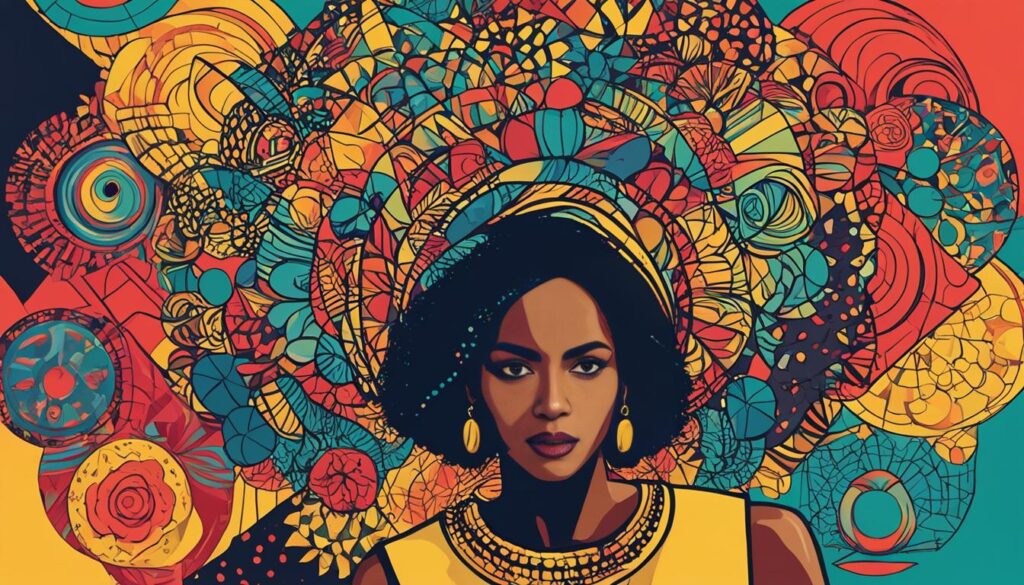If you’re on the hunt for a captivating and thought-provoking audiobook to add to your listening list, look no further than “Girl, Woman, Other” by Bernardine Evaristo. This award-winning novel has taken the literary world by storm, and for good reason.
In this review, we’ll dive into the unique and compelling world created by Evaristo, exploring the rich characters, themes, and narrative techniques that make “Girl, Woman, Other” such a powerful and memorable story. Whether you’re a fan of contemporary fiction or simply looking for an engaging and thought-provoking read, “Girl, Woman, Other” is sure to leave a lasting impression. Let’s begin!
About the Author
Bernardine Evaristo is a British author and professor of creative writing. She was born in London in 1959 to a Nigerian father and an English mother. Evaristo’s writing often explores themes of identity, race, gender, and sexuality through the lens of Black British women’s experiences.
Evaristo has written eight books, including “Blonde Roots” and “Mr. Loverman,” both of which have been highly praised by critics and readers alike. She is also the editor of several anthologies, including “New Daughters of Africa” and “Black Britain: Writing Back.”
In 2019, Evaristo was awarded the prestigious Booker Prize for her novel “Girl, Woman, Other” – the first Black woman to ever receive the award. She was also appointed Officer of the Order of the British Empire (OBE) in 2009 in recognition of her contributions to literature.
Evaristo’s writing style is known for blending prose and poetry, challenging traditional literary forms and structures. She has been celebrated for her ability to capture the complexities of contemporary Black British life with honesty and nuance.
Plot Summary
“Girl, Woman, Other” by Bernardine Evaristo tells the stories of twelve characters, mostly black women, living in present-day Britain. The book explores the themes of identity, race, gender, and feminism as each character’s journey intertwines with others. The audiobook version of the novel is narrated by Anna-Maria Nabirye and spans over eleven hours.
The novel begins with Amma, an award-winning lesbian playwright, who is about to premiere her new play in the National Theatre. The story then shifts to focus on the lives of her friends, family, and acquaintances, all of whom have unique experiences and perspectives on the world around them.
While exploring the different characters and their lives, Evaristo’s work delves into issues of racism, classism, sexism, and intersectionality. The author’s writing style features various techniques, including innovative punctuation and an experimental approach to grammar, which enhance the listening experience.
The central theme of “Girl, Woman, Other” is the interconnectedness of people’s lives, regardless of their differences, and the struggles they face in a world that is constantly changing.
Character Analysis
In “Girl, Woman, Other,” Evaristo creates a diverse cast of characters, each with their own unique experiences, aspirations, and struggles. Through her skillful storytelling, she develops a rich tapestry of intersecting lives that collaborate to form intricate truths about contemporary society.
“Girl, Woman, Other” delves into the complexities of identity representation, particularly among black women, exploring their experiences with love, power, and self-acceptance. From Amma, a gay theatre producer whose revolutionary play upends traditional narratives about race and gender to Winsome, a senior citizen whose search for belonging takes her from Jamaica to London, the novel’s characters represent a wide spectrum of black women’s stories.
One of the most striking aspects of the novel is the amount of depth and nuance that Evaristo infuses into each character’s development. Rather than relying on tired stereotypes and tropes, she creates fully-realized, multidimensional individuals who challenge readers to reconsider their preconceptions. For instance, Carole, a STEM professor who appears to be highly successful on the surface, is grappling with feelings of isolation and anxiety that stem from societal pressure to succeed against entrenched gender and racial biases.
The character of Hattie, a spunky retiree who defies stereotypes about elderly women, is another standout example of Evaristo’s exceptional character writing. Through her humorous quirks and compassionate spirit, Hattie becomes a powerful symbol of resilience and vitality despite the many curveballs that life throws her way.
Ultimately, Evaristo’s “Girl, Woman, Other” succeeds in creating a realistic, fully realized world populated by a diverse array of characters, each of whom contributes meaningfully to the overarching narrative. The novel’s commitment to character complexity and intersectionality make it an engrossing and thought-provoking read for any fan of contemporary fiction.

Writing Style and Narrative Techniques
Bernardine Evaristo’s writing style in “Girl, Woman, Other” is a unique blend of poetry and prose, weaving together multiple narratives through her use of language and structure. Evaristo employs a range of narrative techniques throughout the audiobook, including stream of consciousness, third-person omniscient, and experimental forms of storytelling.
Evaristo’s use of language is both poetic and evocative, with each sentence crafted to convey a deep sense of emotion and introspection. She employs vivid imagery and sensory details to bring her characters and their experiences to life, immersing readers in their worlds.
One notable technique used by Evaristo is her tendency to break up sentences into shorter, punchier fragments, mimicking the rhythm of spoken language. This allows for a more dynamic and engaging storytelling experience, making it easier for readers to follow along with the different narratives.
Evaristo’s nonlinear narrative structure and the use of alternating perspectives provide a multi-dimensional view of the overarching themes of identity, race, and feminism. The audiobook’s unique construction allows for a deeply immersive experience, challenging traditional narrative techniques and offering diverse and nuanced perspectives.
Overall, Evaristo’s writing style and narrative techniques in “Girl, Woman, Other” showcase her ability to weave together a complex and vibrant narrative, creating a truly unforgettable audiobook experience.
Themes and Social Commentary
In “Girl, Woman, Other,” Bernardine Evaristo delves into various crucial themes and provides thought-provoking social commentary. One of the primary themes explored in the book is identity, and how it is shaped by one’s personal experiences and interactions with society. The novel also tackles issues surrounding race, including the impact of systemic racism and the challenges of navigating racial identity in a complex, interconnected world.
Evaristo’s writing also reflects her commitment to feminism, illustrating how gender roles impact the lives of her diverse cast of characters. Through her exploration of intersectionality, she highlights how social constructs such as race, gender, and class intersect to shape one’s life experiences and opportunities.
Overall, “Girl, Woman, Other” is a powerful work that offers nuanced perspectives on a range of issues, illuminating the complexity and richness of human experience.
| Themes | Social Commentary |
|---|---|
| Identity | Impact of systemic racism |
| Race | Challenges of navigating racial identity |
| Feminism | Exploration of gender roles |
| Intersectionality | Impact of social constructs on life experiences |
Audiobook Narration
The audiobook version of “Girl, Woman, Other” is a must-listen for fans of Bernardine Evaristo’s work. Narrated by Anna-Maria Nabirye, the performance is a stunning showcase of the book’s vibrant characters and complex storylines.
Nabirye’s narration captures the essence of each character, from the outspoken Amma to the reserved Winsome. Her attention to detail in delivering each character’s unique voice and personality makes for an incredibly immersive listening experience.
The pacing of the narration is well-suited to the book’s structure, allowing listeners to fully understand each character’s arc before moving onto the next. Nabirye’s ability to differentiate between characters’ voices is impressive, ensuring that listeners are never confused about who is speaking.

While the overall narration is exceptional, there were moments when Nabirye’s delivery felt rushed, leaving listeners struggling to keep up with the dialogue. However, this is a minor issue that does not detract from the overall quality of the performance.
Overall, the audiobook version of “Girl, Woman, Other” is a fantastic way to experience Evaristo’s masterful storytelling. Nabirye’s narration brings the characters and their stories to life in a way that is sure to captivate listeners.
Pacing and Flow
One standout aspect of “Girl, Woman, Other” is its expertly crafted pacing and flow. Evaristo masterfully weaves together the intersecting stories of twelve diverse characters, creating a narrative that seamlessly ebbs and flows between perspectives and time periods.
The novel’s pacing is slow and deliberate, allowing readers to luxuriate in each character’s story while still maintaining a sense of tension and forward momentum throughout. The transitions between characters and time periods are smooth and natural, never jarring or disorienting.
Overall, Evaristo’s careful attention to pacing and flow make “Girl, Woman, Other” a captivating and immersive read from start to finish.
Reception and Impact
Since its release, Girl, Woman, Other has become a critical darling, receiving widespread acclaim for its bold and insightful portrayal of contemporary society. The audiobook was particularly well-received, with reviewers praising the unique voices of each character and the skillful narration brought to life by the talented cast.
In 2019, Girl, Woman, Other won the Booker Prize, cementing its place as a modern classic. The novel also garnered several other awards and nominations, including the Gordon Burn Prize and the Women’s Prize for Fiction.
The novel’s impact has gone beyond awards and accolades, however, touching readers around the world and sparking important conversations about issues of race, gender, and identity. Many have hailed Bernardine Evaristo’s work as a masterpiece that captures the essence of modern life and the experiences of those often underrepresented in literature.
Cultural and Historical Context
In order to fully understand the impact of “Girl, Woman, Other,” one must consider its cultural and historical context. Bernardine Evaristo’s storytelling reflects the current social climate of the United Kingdom, particularly in regards to issues surrounding race and gender. Through her portrayals of diverse and intersectional characters, Evaristo highlights the struggles of those often marginalized in society.
Additionally, “Girl, Woman, Other” is situated within the broader context of contemporary literature, drawing inspiration from writers such as Toni Morrison and Chimamanda Ngozi Adichie. Evaristo’s novel continues the trend of redefining literary conventions and exploring themes that have traditionally been ignored by mainstream publishing.
This cultural and historical context is crucial to understanding the significance of “Girl, Woman, Other” and its impact on contemporary literature. Through her innovative narrative techniques and commitment to diverse representation, Evaristo has created a touching and thought-provoking work that resonates with readers and critics alike.
Comparisons to Other Works by Bernardine Evaristo
Bernardine Evaristo has penned several acclaimed works, including “Mr. Loverman,” “Blonde Roots,” and “Soul Tourists.” While each book carries its own themes and unique narrative styles, they share an underlying focus on social commentary and identity.
“Girl, Woman, Other” stands out for its intersectional portrayal of black womanhood, encompassing a wide range of experiences and perspectives. In contrast, “Blonde Roots” presents a satirical alternate history where Africans enslave Europeans, challenging traditional power dynamics.
Similarly, “Soul Tourists” explores the complexities of the African diaspora and its legacy, weaving elements of magical realism into the narrative. “Mr. Loverman” centers on the experiences of a closeted gay man in his 70s, touching on themes of love, family, and the immigrant experience.
Overall, Evaristo’s works offer a diverse and thought-provoking examination of contemporary society, reflecting on issues of race, gender, sexuality, and more.
Recommendations and Final Thoughts
After experiencing “Girl, Woman, Other” by Bernardine Evaristo in audiobook format, we highly recommend it to anyone seeking a rich and thought-provoking literary work. The story’s diverse characters, compelling narrative, and insightful social commentary make for an engrossing listening experience.
Evaristo’s writing style is both poetic and accessible, making for a captivating journey through the interconnected lives of women of color in contemporary Britain. We appreciated her unique use of form and structure, which added depth and dimensionality to the narrative.
Overall, “Girl, Woman, Other” is a must-read for anyone interested in contemporary literature, feminist themes, and stories that challenge and expand our notions of identity and community.
Conclusion
“Girl, Woman, Other” by Bernardine Evaristo is a must-read audiobook that offers a compelling portrayal of intersectional feminism, identity, and race. Evaristo’s writing style and narrative techniques are praiseworthy, creating an engaging and thought-provoking story that resonates with readers. The characters are dynamic and diverse, adding to the richness of the book. The audiobook narration is outstanding, bringing the story to life with a unique and captivating performance. “Girl, Woman, Other” has received critical acclaim and won several awards, including the Booker Prize, making it a significant contribution to contemporary literature. Overall, “Girl, Woman, Other” is an excellent choice for anyone interested in exploring the complexities of identity and feminism in modern society.”
FAQ
What is “Girl, Woman, Other” by Bernardine Evaristo?
“Girl, Woman, Other” is a novel written by Bernardine Evaristo. It tells the interconnected stories of twelve British individuals, mainly women, as they navigate through different challenges and experiences that are deeply rooted in issues of race, gender, and identity.
Who is Bernardine Evaristo?
Bernardine Evaristo is a renowned British author known for her captivating storytelling and exploration of intersectional identities. She has written numerous novels, plays, and poems, and has been recognized with prestigious awards such as the Booker Prize for Fiction.
What is the plot of “Girl, Woman, Other”?
“Girl, Woman, Other” follows the lives of twelve characters, primarily Black British women, as they navigate their personal struggles, relationships, and aspirations. The novel explores themes of identity, culture, and interconnectedness while shedding light on the modern-day Black British experience.
How are the characters in “Girl, Woman, Other” portrayed?
The characters in “Girl, Woman, Other” are vibrant, diverse, and complex. Evaristo delves deep into their backgrounds, motivations, and inner worlds, providing readers with a rich understanding of each character’s journey and their impact on the overall narrative.
What is Bernardine Evaristo’s writing style like in “Girl, Woman, Other”?
Evaristo’s writing style in “Girl, Woman, Other” is bold, lyrical, and immersive. She captivates readers with her use of poetic language, unconventional sentence structure, and unique narrative techniques, creating a distinct reading experience that keeps readers engrossed from start to finish.
What themes and social commentary are present in “Girl, Woman, Other”?
“Girl, Woman, Other” tackles a wide range of themes and provides insightful social commentary on issues such as race, feminism, identity, sexuality, and intersectionality. Evaristo delves fearlessly into these topics, challenging societal norms and shedding light on the experiences of marginalized individuals.
How is the audiobook narration of “Girl, Woman, Other”?
The audiobook narration of “Girl, Woman, Other” is skillfully performed, bringing the characters and their stories to life. The narrators’ expressive voices and nuanced delivery enhance the immersive experience of the audiobook, making it a compelling choice for those who prefer listening to books.
How is the pacing and flow in “Girl, Woman, Other”?
Evaristo expertly balances the pacing and flow in “Girl, Woman, Other,” creating a narrative that seamlessly transitions between characters and storylines. The book maintains a consistent rhythm, drawing readers deeper into the interconnected stories while keeping the plot engaging and the pages turning.
How has “Girl, Woman, Other” been received by critics and readers?
“Girl, Woman, Other” has garnered widespread critical acclaim and has resonated with readers around the world. It has been praised for its thought-provoking narratives, compelling characters, and its resounding impact on contemporary literature. The novel has also received several awards and nominations, solidifying its significance within the literary landscape.
Is “Girl, Woman, Other” influenced by cultural and historical context?
Absolutely. “Girl, Woman, Other” is deeply influenced by cultural and historical context, particularly the Black British experience. Evaristo skillfully weaves cultural references and historical events into the narrative, providing readers with a greater understanding of the characters’ backgrounds and the societal forces that shape their lives.
How does “Girl, Woman, Other” compare to other works by Bernardine Evaristo?
“Girl, Woman, Other” shares similarities with Evaristo’s other works, such as her exploration of identity, her vibrant writing style, and her commitment to representing marginalized voices. However, it also showcases the author’s evolution, demonstrating her ability to tackle multiple perspectives and narratives in a single compelling story.
Would you recommend “Girl, Woman, Other” as an audiobook?
Absolutely. “Girl, Woman, Other” is a powerful and engaging audiobook experience. The exceptional narration, combined with Evaristo’s captivating storytelling, makes it a highly recommended choice for fans of audiobooks or anyone seeking a thought-provoking and immersive literary journey.
What are the final thoughts on “Girl, Woman, Other” as an audiobook?
“Girl, Woman, Other” stands out as a remarkable audiobook that should not be missed. Evaristo’s compelling narratives, diverse and complex characters, and impactful social commentary make it a must-listen experience. Whether you’re already a fan of Bernardine Evaristo or curious about exploring her work, “Girl, Woman, Other” is a remarkable entry point.



